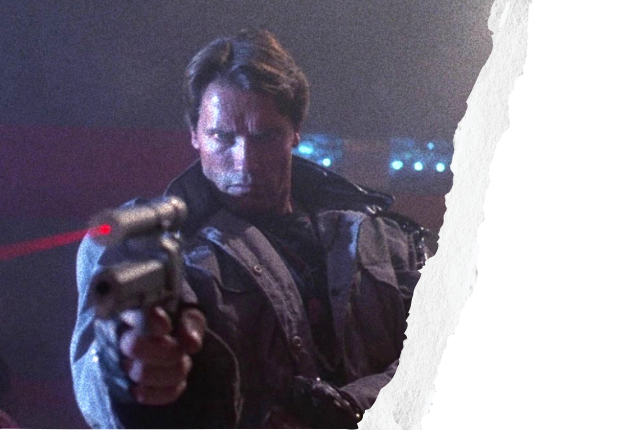The Terminated
“You can’t just go around killing people.”
“Why not?”
The legalization and speedy embrace of abortion in the mid-20th century led to widespread cultural and psychological trauma. The Terminator movies by James Cameron are an expression of this trauma. The fact that the first two movies made a quarter of a billion dollars at the box office when they were initially released should say something. What made these movies resonate? The answer lies in what made them so terrifying, yet so perfectly relatable. They’re pro-natal dystopian Biblical fantasies of a man and woman pushing backing against state-sponsored abortion.
These beloved action blockbusters are surreal horror fables. Their violent visions bubble up from so much unconscious dread and pain, hidden in the hearts of modern men and women. The horrors channeled by these films were inflicted by the state as it sanctioned and unleashed abortion upon the masses, furthering the deterioration of the nuclear family and the mental well-being of Western Women. The fact that men stood idly by and let this happen, not protecting their wives and daughters, only deepened the wounds.
The Terminator films employ a variety of binaries: man and woman; angel and demon; bugmen and real human beings. These archetypal characters fill the screen with visions of violence and pain; husbands kept from their wives, mothers locked away from their children, an all-seeing, unstoppable force that seeks the destruction of the unborn and an end to the human race. They are visions of our modern reality. The films act as a temple drama for our times.
The first film opens with a prologue explaining the rise of these “machines” — a collective of soulless, bodiless algorithms that have determined that mankind must be exterminated, all for the good of the planet. The machines, like the demons Christ cast into the swine, do not have real physical bodies. They do not want babies to have bodies, either. In the film, they are depicted as replicas of men. They are like so many pushing their anti-human agenda today, who act as though they were never conceived and had no mothers or fathers. They simply exist as perfect units, made to follow orders from some psychotic hive-mind.
We begin in Los Angeles, 2029. A machine tank rolls over the skulls of the dead, its police lights emblematic of the incorporeal state’s power and authority. We are shown scenes of righteous men battling the machines. Their struggle is evocative of the war in heaven written of in John’s Revelation, where we read that Michael and his angels fought against the dragon Lucifer.
Immediately following these scenes of war, we see the Terminator appear in Los Angeles, 1984. He has been cast out of his world and into ours. He appears nude, his body that of a god’s, but his flesh and bones artificial. He does not possess a real body, only the form of one. Later in the film he appears staring at himself in the mirror with flies buzzing around his head. Like all abortionists, (i.e. enders of life), he is Beelzebub, Lord of the Flies. This angel of darkness has one mission: to prevent a woman from giving birth. He exists solely to TERMINATE Sarah Connor’s pregnancy. The cyborg’s evocative moniker is no coincidence.
Following this devil, we meet another character. He is a mortal man named Kyle. He is all of us. We see the scars on his body of flesh and blood. He awakens, nude, also cast out of his home. No parents, no social safety net for him. He stumbles, Adam-like, among the hobos and vagrants in the lonely and dreary world of modern California. He wants for more than just mere survival. He searches for his companion.
Enter Sarah, the first female character in the film. The scene changes from dark, dreary, and shrouded in death, to light and pleasant. Sarah wears a pink dress and an apron: emblems of femininity. She rides a Vespa down the street. Pleasant music accompanies her arrival; her beauty is a reprieve for the senses. Sarah is named for Abraham’s wife in the Old Testament. She is not some girlboss, she is not “kicking ass” or “taking names.” She simply represents womanhood in its full bloom, with its limitless potential, godlike powers of creation, and prospect of eternal life (i.e. eternal progeny). God says of the biblical Sarah, “Yea, I will bless her, and she shall be a mother of nations; kings of people shall be of her.”
Sarah Conner, like Mother Eve, must also reckon with the fallen world she inhabits. She works as a waitress, serving others food, cleaning up their messes. But she is mistreated by men, women, and children. She is forced by circumstance to do domestic work, but always for strangers and never for her own family. She is the emblem of modern woman, cast into a corporate world that confounds her feminine instincts while offering her zero guidance, zero way out.
Sarah is surrounded by rudeness, hopelessness, and nihilism. A co-worker reminds Sarah of her own mortality when, in a weak attempt at comforting her after a rough day, she states: “Look at it this way, in a hundred years who’s gonna care?” Sarah returns home, but not to a loving husband and family. Instead, she nurtures an iguana in place of an infant. It’s a moment so disordered as to be comic relief, but it hits very close to home in the current year. “Mind your mother,” she murmurs to the reptile. “Pugsley still loves me, don’t you baby?” Her roommate, Ginger, declares of Sarah’s cooing: “Disgusting.” Maybe rightly so, but like so many pupperino “dog moms,” she is merely acting upon deeply ingrained maternal instincts.
Sarah wears a t-shirt imprinted with the image of the Jetsons, calling to mind visions of a nuclear family of the future. It is a vision of hope from when we thought technology would actually help us, and we would all live above the earth in the beautiful utopian sky. She longs for a man to save her, longs for motherhood, and dreams of domesticity.
Eventually Kyle finds her. He is the first man of action Sarah may have encountered in her entire life. He uses the divine power of human agency (a gift no cyborg could ever possess) to reach out and alter the fabric of space and time. “Come with me if you wanna live,” he states with hand extended. His offer is the one all men make to the women they love. It is the offer of matrimony, and a chance at vita aeterna.
Sarah faces many struggles throughout both films, including Cassandra’s trial from Greek myth: the ability to prophesy, but never be believed. When she tells others there is a war against the unborn, she is labeled a crazy “Karen” and locked in an insane asylum for her “delusions of persecution.” She may as well be a redpilled millennial spouting about the impending fertility disaster on pre-Musk Twitter, cancelled for her racist and objectionable “conspiracy theories.”
In the end, though, after Kyle giving his life and Sarah enlisting the help of a guardian angel (the T-800 in Terminator 2: Judgment Day), they subdue the demonic forces. Sarah is finally allowed to live in peace, albeit as a widow. The reign of “the terminators” is ended.
A self-aware artificial intelligence sending cyborg executioners back in time to murder a baby is both a ludicrous and utterly compelling premise for a film. This is because it captures the absolute audacity of abortion: believing that one can “time travel” in order to undo something that has already happened. No matter how much you abort a “fetus,” you can never actually erase history. You did the deed; you conceived a child. A sentient being was created with its own unique DNA and genetics and body. There is no actual portal through time that can ever change that fact. There are only demons masquerading as men.
What does it say that the ultimate happy ending to this blockbuster is merely a world where babies are allowed to be born in peace? It’s not fabulous wealth or fame, or an end to all human suffering. It’s the end of infanticide and the recentering of the nuclear family unit. This is all that Sarah really desires. It is an ending most people desire. The heroism depicted in these films stems from men taking up the call to push back against the anti-human algorithm and penetrating a conceivable new dawn.
“The unknown future rolls toward us,” narrates Sarah Connor at the end of Terminator 2. “I face it, for the first time, with a sense of hope. Because if a machine, a Terminator, can learn the value of human life, maybe we can too.”
































